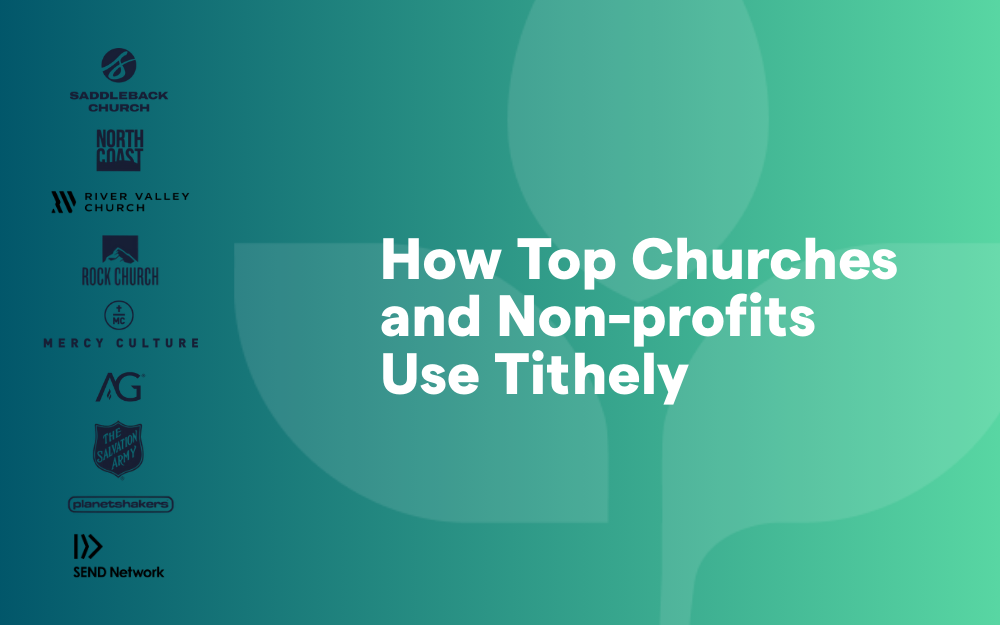How to Thank Your Church for Their Financial Support: 5 Easy Ways!

God calls all believers to give to their church. Tithing in the Bible, giving, and generosity are well-known biblical principles. But this doesn’t mean your church can’t also thank people who give generously.
No one should give for the praise, but it doesn’t hurt to be appreciated.
One of the best ways your church can show thanks to donors is through giving emails and letters. These are opportunities to show thanks, encourage future giving, and continue to share the church’s message. Here five different times your church can send out these communications.
#1. Online donation
Your church should send out an automated email anytime someone makes a donation on your website. The first thing this does is confirm that their gift has been received. But this is also an excellent opportunity to thank them and show what their contribution is going towards.
Tithe.ly customers can customize the email confirmations that get sent to all donors. Add a personalized subject line, image header, text, and email signature within the Tithe.ly platform. The donor’s name and gift amount will be automatically added.
Keep this pretty short and simple. This is a message that donors will get frequently, so don’t expect them to read it every time. This is also a template you should update (monthly or quarterly), so the content doesn’t get stale or outdated.
Related: 9 Proven Strategies to Increase Online Giving In Your Church
#2. Year-end giving
Like all nonprofits, churches need to send out a year-end contribution statement. This allows your church members to include their charitable contributions when they file their taxes. After all, a tax write-off is one of the reasons why your members’ give . But hopefully, not the only reason.
Hopefully, they also give because it makes a difference in the life of your church. Let them know how they’re doing that. Give them an overview of everything your church accomplished over the past year—the number of baptisms, mission trips, community projects, etc.
#3. Welcome new donors
If you add new donors into your email system, this could be an opportunity to welcome them to your church. Many church management systems (ChMS) will allow you to automate welcome emails that get sent to new people added to your list.
This is also your chance to tell new people other ways they can get involved in your church beyond giving. Connect them with ways to join a small group or volunteer. This isn’t something you’ll regularly have to update because it’s an email they’ll only get once. So make it count.
You can also send physical letters to new donors. Want to see some examples? The unSeminary blog has about a dozen for you to check out on their website.
#4. Event or special project giving
Christmas and Easter are two of the biggest days of worship attendance in the life of any church. They can also be two big opportunities to capitalize on giving. So can other significant events and special projects on your church’s calendar.
Related: 7 Tips for Raising Funds via Special Offerings During the Christmas Season
Be sure to keep that momentum going by creating specialized follow-ups to people who give on these occasions. Write letters specifically for givers on Christmas and Easter. Many churches give to specific funds or missions on these holidays. Tell people where their money is going and why.
Many churches also do significant capital campaigns when they’re raising money for something big, like a building renovation. These campaigns take a lot of organization and planning to get started. They should also include a plan to thank those who gave to the campaign.
#5. Major gifts
Most of the gifts your church receives are going to be relatively small. They’ll be a regular donation from a middle-class family or a one-time gift from a first-time visitor. But every once in a while, your church might be blessed with a major contribution.
That’s not to say that this donor is any more special than anyone else in your church. But this isn’t a reason why your church shouldn’t say thank you for such a generous gift. These are good opportunities to send personal notes from your senior pastor or another staff member. You can have a basic template to work from, but these should feel more individualized.
If you want to learn more about a major giving plan, Generis has many free resources you can read or download from their site.
It’s difficult for your church to plan on getting large donations, but it helps to be ready if and when that happens.
How does your church thank donors? Share your tips in the comments below!
Editor's Note: This is a guest post from Robert Carnes. Robert is a writer and storyteller. He's the author of The Original Storyteller: Become a Better Storyteller in 30 Days. A former church communicator and nonprofit marketer, Robert works as a managing editor for Orange in Atlanta.
Sign Up for Product Updates
God calls all believers to give to their church. Tithing in the Bible, giving, and generosity are well-known biblical principles. But this doesn’t mean your church can’t also thank people who give generously.
No one should give for the praise, but it doesn’t hurt to be appreciated.
One of the best ways your church can show thanks to donors is through giving emails and letters. These are opportunities to show thanks, encourage future giving, and continue to share the church’s message. Here five different times your church can send out these communications.
#1. Online donation
Your church should send out an automated email anytime someone makes a donation on your website. The first thing this does is confirm that their gift has been received. But this is also an excellent opportunity to thank them and show what their contribution is going towards.
Tithe.ly customers can customize the email confirmations that get sent to all donors. Add a personalized subject line, image header, text, and email signature within the Tithe.ly platform. The donor’s name and gift amount will be automatically added.
Keep this pretty short and simple. This is a message that donors will get frequently, so don’t expect them to read it every time. This is also a template you should update (monthly or quarterly), so the content doesn’t get stale or outdated.
Related: 9 Proven Strategies to Increase Online Giving In Your Church
#2. Year-end giving
Like all nonprofits, churches need to send out a year-end contribution statement. This allows your church members to include their charitable contributions when they file their taxes. After all, a tax write-off is one of the reasons why your members’ give . But hopefully, not the only reason.
Hopefully, they also give because it makes a difference in the life of your church. Let them know how they’re doing that. Give them an overview of everything your church accomplished over the past year—the number of baptisms, mission trips, community projects, etc.
#3. Welcome new donors
If you add new donors into your email system, this could be an opportunity to welcome them to your church. Many church management systems (ChMS) will allow you to automate welcome emails that get sent to new people added to your list.
This is also your chance to tell new people other ways they can get involved in your church beyond giving. Connect them with ways to join a small group or volunteer. This isn’t something you’ll regularly have to update because it’s an email they’ll only get once. So make it count.
You can also send physical letters to new donors. Want to see some examples? The unSeminary blog has about a dozen for you to check out on their website.
#4. Event or special project giving
Christmas and Easter are two of the biggest days of worship attendance in the life of any church. They can also be two big opportunities to capitalize on giving. So can other significant events and special projects on your church’s calendar.
Related: 7 Tips for Raising Funds via Special Offerings During the Christmas Season
Be sure to keep that momentum going by creating specialized follow-ups to people who give on these occasions. Write letters specifically for givers on Christmas and Easter. Many churches give to specific funds or missions on these holidays. Tell people where their money is going and why.
Many churches also do significant capital campaigns when they’re raising money for something big, like a building renovation. These campaigns take a lot of organization and planning to get started. They should also include a plan to thank those who gave to the campaign.
#5. Major gifts
Most of the gifts your church receives are going to be relatively small. They’ll be a regular donation from a middle-class family or a one-time gift from a first-time visitor. But every once in a while, your church might be blessed with a major contribution.
That’s not to say that this donor is any more special than anyone else in your church. But this isn’t a reason why your church shouldn’t say thank you for such a generous gift. These are good opportunities to send personal notes from your senior pastor or another staff member. You can have a basic template to work from, but these should feel more individualized.
If you want to learn more about a major giving plan, Generis has many free resources you can read or download from their site.
It’s difficult for your church to plan on getting large donations, but it helps to be ready if and when that happens.
How does your church thank donors? Share your tips in the comments below!
Editor's Note: This is a guest post from Robert Carnes. Robert is a writer and storyteller. He's the author of The Original Storyteller: Become a Better Storyteller in 30 Days. A former church communicator and nonprofit marketer, Robert works as a managing editor for Orange in Atlanta.
podcast transcript
God calls all believers to give to their church. Tithing in the Bible, giving, and generosity are well-known biblical principles. But this doesn’t mean your church can’t also thank people who give generously.
No one should give for the praise, but it doesn’t hurt to be appreciated.
One of the best ways your church can show thanks to donors is through giving emails and letters. These are opportunities to show thanks, encourage future giving, and continue to share the church’s message. Here five different times your church can send out these communications.
#1. Online donation
Your church should send out an automated email anytime someone makes a donation on your website. The first thing this does is confirm that their gift has been received. But this is also an excellent opportunity to thank them and show what their contribution is going towards.
Tithe.ly customers can customize the email confirmations that get sent to all donors. Add a personalized subject line, image header, text, and email signature within the Tithe.ly platform. The donor’s name and gift amount will be automatically added.
Keep this pretty short and simple. This is a message that donors will get frequently, so don’t expect them to read it every time. This is also a template you should update (monthly or quarterly), so the content doesn’t get stale or outdated.
Related: 9 Proven Strategies to Increase Online Giving In Your Church
#2. Year-end giving
Like all nonprofits, churches need to send out a year-end contribution statement. This allows your church members to include their charitable contributions when they file their taxes. After all, a tax write-off is one of the reasons why your members’ give . But hopefully, not the only reason.
Hopefully, they also give because it makes a difference in the life of your church. Let them know how they’re doing that. Give them an overview of everything your church accomplished over the past year—the number of baptisms, mission trips, community projects, etc.
#3. Welcome new donors
If you add new donors into your email system, this could be an opportunity to welcome them to your church. Many church management systems (ChMS) will allow you to automate welcome emails that get sent to new people added to your list.
This is also your chance to tell new people other ways they can get involved in your church beyond giving. Connect them with ways to join a small group or volunteer. This isn’t something you’ll regularly have to update because it’s an email they’ll only get once. So make it count.
You can also send physical letters to new donors. Want to see some examples? The unSeminary blog has about a dozen for you to check out on their website.
#4. Event or special project giving
Christmas and Easter are two of the biggest days of worship attendance in the life of any church. They can also be two big opportunities to capitalize on giving. So can other significant events and special projects on your church’s calendar.
Related: 7 Tips for Raising Funds via Special Offerings During the Christmas Season
Be sure to keep that momentum going by creating specialized follow-ups to people who give on these occasions. Write letters specifically for givers on Christmas and Easter. Many churches give to specific funds or missions on these holidays. Tell people where their money is going and why.
Many churches also do significant capital campaigns when they’re raising money for something big, like a building renovation. These campaigns take a lot of organization and planning to get started. They should also include a plan to thank those who gave to the campaign.
#5. Major gifts
Most of the gifts your church receives are going to be relatively small. They’ll be a regular donation from a middle-class family or a one-time gift from a first-time visitor. But every once in a while, your church might be blessed with a major contribution.
That’s not to say that this donor is any more special than anyone else in your church. But this isn’t a reason why your church shouldn’t say thank you for such a generous gift. These are good opportunities to send personal notes from your senior pastor or another staff member. You can have a basic template to work from, but these should feel more individualized.
If you want to learn more about a major giving plan, Generis has many free resources you can read or download from their site.
It’s difficult for your church to plan on getting large donations, but it helps to be ready if and when that happens.
How does your church thank donors? Share your tips in the comments below!
Editor's Note: This is a guest post from Robert Carnes. Robert is a writer and storyteller. He's the author of The Original Storyteller: Become a Better Storyteller in 30 Days. A former church communicator and nonprofit marketer, Robert works as a managing editor for Orange in Atlanta.
VIDEO transcript
God calls all believers to give to their church. Tithing in the Bible, giving, and generosity are well-known biblical principles. But this doesn’t mean your church can’t also thank people who give generously.
No one should give for the praise, but it doesn’t hurt to be appreciated.
One of the best ways your church can show thanks to donors is through giving emails and letters. These are opportunities to show thanks, encourage future giving, and continue to share the church’s message. Here five different times your church can send out these communications.
#1. Online donation
Your church should send out an automated email anytime someone makes a donation on your website. The first thing this does is confirm that their gift has been received. But this is also an excellent opportunity to thank them and show what their contribution is going towards.
Tithe.ly customers can customize the email confirmations that get sent to all donors. Add a personalized subject line, image header, text, and email signature within the Tithe.ly platform. The donor’s name and gift amount will be automatically added.
Keep this pretty short and simple. This is a message that donors will get frequently, so don’t expect them to read it every time. This is also a template you should update (monthly or quarterly), so the content doesn’t get stale or outdated.
Related: 9 Proven Strategies to Increase Online Giving In Your Church
#2. Year-end giving
Like all nonprofits, churches need to send out a year-end contribution statement. This allows your church members to include their charitable contributions when they file their taxes. After all, a tax write-off is one of the reasons why your members’ give . But hopefully, not the only reason.
Hopefully, they also give because it makes a difference in the life of your church. Let them know how they’re doing that. Give them an overview of everything your church accomplished over the past year—the number of baptisms, mission trips, community projects, etc.
#3. Welcome new donors
If you add new donors into your email system, this could be an opportunity to welcome them to your church. Many church management systems (ChMS) will allow you to automate welcome emails that get sent to new people added to your list.
This is also your chance to tell new people other ways they can get involved in your church beyond giving. Connect them with ways to join a small group or volunteer. This isn’t something you’ll regularly have to update because it’s an email they’ll only get once. So make it count.
You can also send physical letters to new donors. Want to see some examples? The unSeminary blog has about a dozen for you to check out on their website.
#4. Event or special project giving
Christmas and Easter are two of the biggest days of worship attendance in the life of any church. They can also be two big opportunities to capitalize on giving. So can other significant events and special projects on your church’s calendar.
Related: 7 Tips for Raising Funds via Special Offerings During the Christmas Season
Be sure to keep that momentum going by creating specialized follow-ups to people who give on these occasions. Write letters specifically for givers on Christmas and Easter. Many churches give to specific funds or missions on these holidays. Tell people where their money is going and why.
Many churches also do significant capital campaigns when they’re raising money for something big, like a building renovation. These campaigns take a lot of organization and planning to get started. They should also include a plan to thank those who gave to the campaign.
#5. Major gifts
Most of the gifts your church receives are going to be relatively small. They’ll be a regular donation from a middle-class family or a one-time gift from a first-time visitor. But every once in a while, your church might be blessed with a major contribution.
That’s not to say that this donor is any more special than anyone else in your church. But this isn’t a reason why your church shouldn’t say thank you for such a generous gift. These are good opportunities to send personal notes from your senior pastor or another staff member. You can have a basic template to work from, but these should feel more individualized.
If you want to learn more about a major giving plan, Generis has many free resources you can read or download from their site.
It’s difficult for your church to plan on getting large donations, but it helps to be ready if and when that happens.
How does your church thank donors? Share your tips in the comments below!
Editor's Note: This is a guest post from Robert Carnes. Robert is a writer and storyteller. He's the author of The Original Storyteller: Become a Better Storyteller in 30 Days. A former church communicator and nonprofit marketer, Robert works as a managing editor for Orange in Atlanta.



























